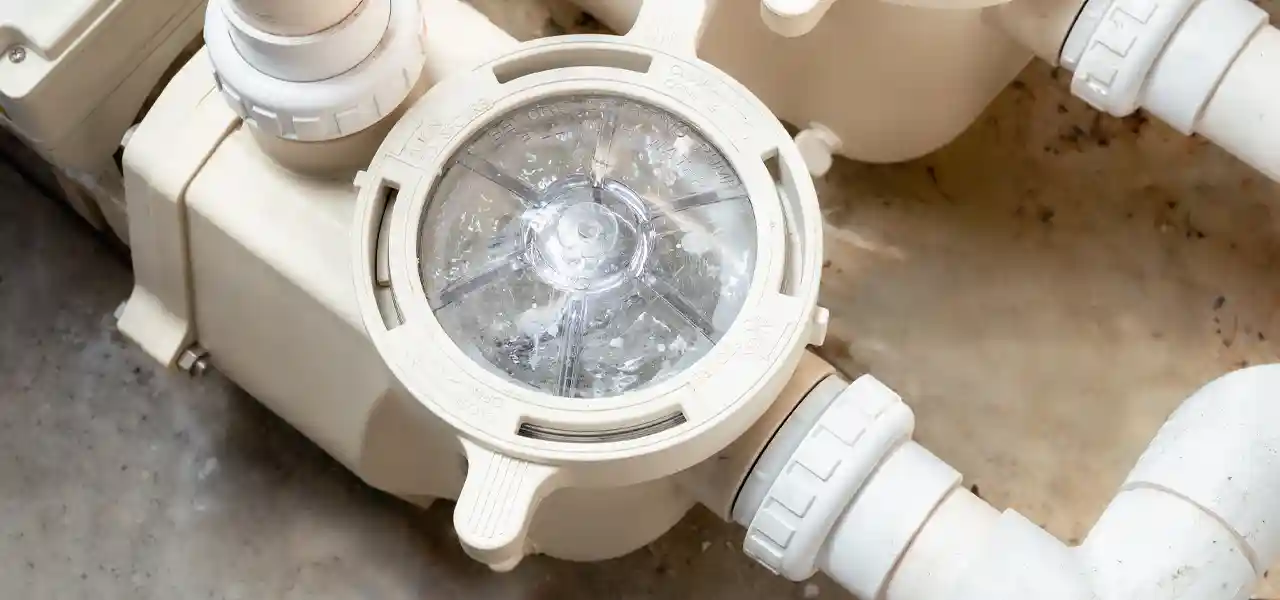FREE Standard Shipping On All Orders $100 or More!*

Swimming Pool Feet of Head Calculations
When building an inground pool, the best way to size the pool pump is to calculate the total resistance in your pool pipes and plumbing, adding up all of the pipe, fittings, valves and other equipment, to come up with Total Resistance, measured in feet of head.
What is Feet of Head?

The resistance in a pool system, or pool feet of head, is what the pump has to overcome, and can also be thought of as Friction Energy. Forcing the water through pipes and all of the twists and turns it makes increases friction, on both the suction side (before the pump) and pressure side (after the pump).
Pool pumps produce different flow rates at varying levels of resistance. To best match a pool pump size to the pool filter's design flow rate, the pool pump feet of head must be known, or at least approximated. Pool pump flow charts, or performance charts, list resistance on the vertical axis, expressed in feet of head. Knowing the resistance of your own pool plumbing helps select the pump size that will deliver the necessary water flow for the filter - not too little, and not too much.
As you can see with the pump flow curve on the right, at different levels of resistance (vertical axis) will produce different levels of water flow (horizontal axis). Each line on the chart represents a particular pump horsepower. The higher the pool feet of head, the lower the flow rate. Use pump flow charts to select a horsepower to match your pool system resistance to your pool filter Design Flow Rate.
Variable Speed Pool Pumps
The more expensive variable speed pumps actually 'sense' the feet of head in the system, and automatically adjust to the most efficient speeds. The newer breed of VS pumps do not have this capability or as many programming options. However, installing a variable speed pool pump on your inground pool will remove much of the necessity of calculating resistance and consulting the chart for many pool pumps (each pump has their own flow chart, or pump curve). To know which speed works best for different functions like filtering, heating, cleaning, spa or water features, it is useful to know the resistance, to maximize efficiency, and not overwork the pump.
How to Calculate Pool Feet of Head
1. Add the total length of PVC pipe in the system

Take your time with this measurement to estimate the linear feet of underground plumbing, horizontal and vertical sections of pipe, to and from the pool. As a minimum, you'll have the skimmer and main drain pipes, and the return piping. Add up all of the underground plumbing pipe to the pipes you can see above ground, in between the pump, filter and heater.
The amount of friction loss in PVC pipe will also depend on how fast the water is flowing through the pipe. For this reason, you want to approximate the flow, in gallons per minute (gpm) that will be flowing through the pipes. Generally this figure will be close to your pool filter Design Rate of Flow, which is somewhere between 50-100 gpm for most backyard pools, but check your filter specs to be sure.
Finally, when you have the total lengths of pipe all added up, horizontal and vertical lengths of pipe, and you know the pool filter rate of flow, you can calculate how many feet of head the pool pipes are contributing. Note that PVC flex pipe is over a third more restrictive than rigid PVC pipe, shown in the charts below.
1.5" PVC Pipe
| GPM | Velocity | Head Loss* |
|---|---|---|
| 25 | 3.94 | 3.8 |
| 30 | 4.73 | 5.2 |
| 35 | 5.52 | 7 |
| 40 | 6.3 | 8.9 |
| 45 | 7.09 | 11.1 |
| 50 | 7.88 | 13.5 |
| 60 | 9.46 | 18.9 |
| 70 | 11.03 | 25.1 |
| 80 | - | - |
| 90 | - | - |
| 100 | - | - |
| *Head loss per 100ft of sch. 40 PVC pipe |
2" PVC Pipe
| GPM | Velocity | Head Loss* |
|---|---|---|
| 25 | 2.39 | 1.11 |
| 30 | 2.87 | 1.55 |
| 35 | 3.35 | 2.06 |
| 40 | 3.82 | 2.63 |
| 45 | 4.3 | 3.28 |
| 50 | 4.78 | 4 |
| 60 | 5.74 | 5.6 |
| 70 | 6.69 | 7.4 |
| 80 | 7.65 | 9.5 |
| 90 | 8.6 | 11.8 |
| 100 | 9.56 | 14.4 |
| *Head loss per 100ft of sch. 40 PVC pipe |
2. Add the 90° and 45° pipes used in the plumbing
Calculate the length of all 90° and 45° pipes above and below ground. You may have to make educated guesses if the pipes are already buried, or if your pool is not yet built, you can draw a diagram to help view the number of 90° and 45° fittings needed. Using two 45's in place of one 90 can reduce resistance by several feet of head. Even couplings add resistance, so try to use long, straight lengths of pipe, with as few connections and bends as possible.
| Pipe Fittings | 1.5" Fittings Head Loss | 2" Fittings Head Loss |
|---|---|---|
| 90° Elbow | 7.5 | 8.6 |
| 45° Elbow | 2.2 | 2.8 |
| Tee | 5.7 | 7.8 |
| Coupling | 1.5 | 2.1 |
3. Add the valves or reducers used in the system
These will all be above ground and visible. Directional valves like Jandy 3-way valves, or 2-way ball valves have some resistance as the water passes through them. Same for check valves, or one-way flow valves, which add more resistance to the system. Unless you have a cartridge filter, your pool filter has a backwash valve, either a push-pull or a multiport valve. Reducers are used to step down the pipe size, typically from 2" to 1.5". If your pipe size reduces at any point, a great deal of resistance is added.
| Valves or Reducers | 1.5" Valve Head Loss* | 2" Valve Head Loss* |
|---|---|---|
| 3-way | 2.8 | 2.4 |
| 2-way | 1.1 | 0.8 |
| Check valve | 1.5 | 1.8 |
| Push pull valve | 12.5 | 16.4 |
| Mulitport valve | 9.3 | 3.3 |
| *At 70 gpm | *At 70 gpm |
4. Add up the equipment used in the system
These are also above the ground and visible. Pool filters and heaters add a great deal of resistance as the water is pushed through them. Chlorinators or purifiers add a smaller amount of resistance, and can be plumbed into a bypass loop to reduce resistance. In the pool, the skimmers, main drain and return eyeballs also contribute several feet of head.
| Equipment | Head Loss* |
|---|---|
| D.E. filter | 6.1 |
| Sand filter | 21.5 |
| Cartridge filter | 16.2 |
| Skimmer | 3.1 |
| Main drain | 1.8 |
| Return eyeball | 5.5 |
| Heater | 9.3 |
| *At 70 gpm |
Total Resistance = Pool Feet of Head
When adding up the total pool feet of head, you may decide to upsize the pipe diameter to 2", especially if your equipment is located more than 50' from the pool. Increasing the pipe size is always preferable to increasing pump horsepower size to compensate for excess resistance.
Start with the pool filter design flow rate, and match the pump accordingly, to produce the desired flow rate, in the presence of all of these flow-restricting items above. Also consider that as the filter gets dirty, it gets more restrictive, and for this reason, some pool builders account for this when selecting the pump or filter.